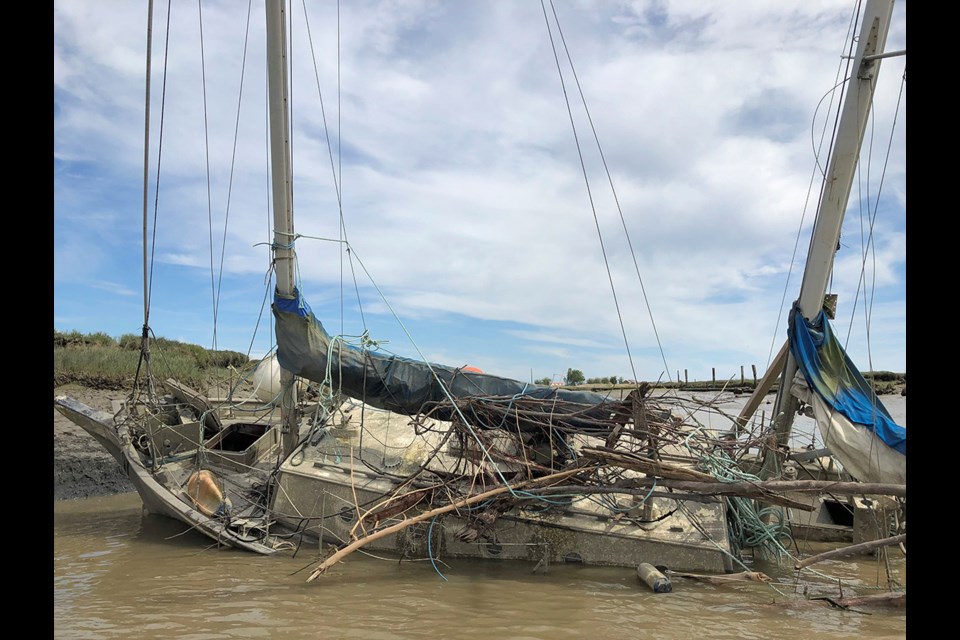A year after it sunk into the Fraser River, a sailboat has finally been removed from its resting place just off Garry Point.
Last month, the Via Mare was removed by Transport Canada under the authority of the Wrecked, Abandoned or Hazardous Vessels Act (WAHVA).
It all started with Richmond resident Allisa Ritchie, who said she has been following the Via Mare’s sad journey over the past year, since she first noticed it tied up to a post in the channel west of Garry Point in January 2020.
“We know this area pretty well, and there’s never any sailboats in that channel to the west,” said Ritchie. “So as soon as I saw it the first time, I knew that something was wrong.”
It was soon moved to the dock at Scotch Pond – which Ritchie said is used by fishers in the area – then moved again to a post in the river channel.
“I thought, oh, (the owner’s) definitely in trouble because they don’t have a place to go, or maybe the engine stopped working – who knows,” added Ritchie.
But, regardless, a storm in late January of last year spelled the end of the Via Mare, said Ritchie.
It was torn from where it was temporarily tied up and marooned on the grassy embankment, before it was finally pushed to its resting place in the channel about 500 metres northwest of the tip of Garry Point, where it remained for the next year.
“As soon as I saw it on the grass tied up, I thought, this boat is going to sink. And so we just progressively watched it get further and further into the water,” Ritchie said, adding the sailboat was regularly visible at low tide, but when the tide was high only the masts could be seen above the water.
She reported the vessel to the coast guard in February 2020 but, while an orange flag appeared near the Via Mare shortly afterwards – possibly placed by authorities – the boat remained, falling into disrepair in the mud and river waters.
But the vessel didn’t seem entirely abandoned – Ritchie, along with her husband and son, made a few trips out to it in their Zodiac, and it appeared at some point last spring that someone had tried to remove it from the channel.
“My son and I were on the land and we saw a tackle box, or a winch, and it looked like somebody was trying to retrieve it. There were big, long ropes leading to the sailboat, (but) it looked like it just wasn’t successful,” said Ritchie.
“We went back again later on in the summer… It was still there, but it was pushed around more and was totally muddy. It was really sad by then, because everything was still in it. There was a bike and a barbeque and cushions – everything.”
While Ritchie’s visits to the sailboat came to an end as the seasons and weather turned, she still kept an eye out for it on her daily walks, its mast visible from the tip of Garry Point, until one day, it was finally gone.
Abandoned vessels an issue nationwide
Abandoned and derelict vessels are a common problem, according to the federal agency, which has received over 155 reports of abandoned or wrecked boats across the country since January 2020.
And, between April 2020 and March of this year, Transport Canada removed five abandoned vessels and assessed 15 vessels in the Fraser River, according to the federal agency.
The federal government has also previously taken action to remove vessels in Richmond. For example, in 2019, Transport Canada provided funds to remove 10 abandoned boats in B.C., including some at Steveston Harbour.
Abandoned vessels, as well as wrecked buoys, can pose environmental, navigational and economic hazards in Canada’s waterways, according to Transport Canada.
“They may also pose a risk to human health and safety and are a source of pollution to local sediment,” the agency said.
While it took a year to remove the Via Mare, Transport Canada told the Richmond News that removal time is on a case-by-case basis, and dependent upon a variety of factors including a risk assessment.
The Via Mare, while abandoned, wasn’t found to pose a hazard or serious environmental impact, according to Transport Canada.
The WAHVA, which came into force in 2019, is administered by Transport Canada as well as the Canadian Coast Guard, which maintains a database of reports for vessels of concern. Transport Canada is responsible for “making final determinations on abandoned vessels.”
The act makes it illegal to abandon vessels, increases owner responsibility and liability for their vessels and allows the federal government to “proactively intervene to address problem vessels that pose hazards.”
In the case of the Via Mare, an enforcement assessment conducted by Transport Canada found further action was not necessary.



